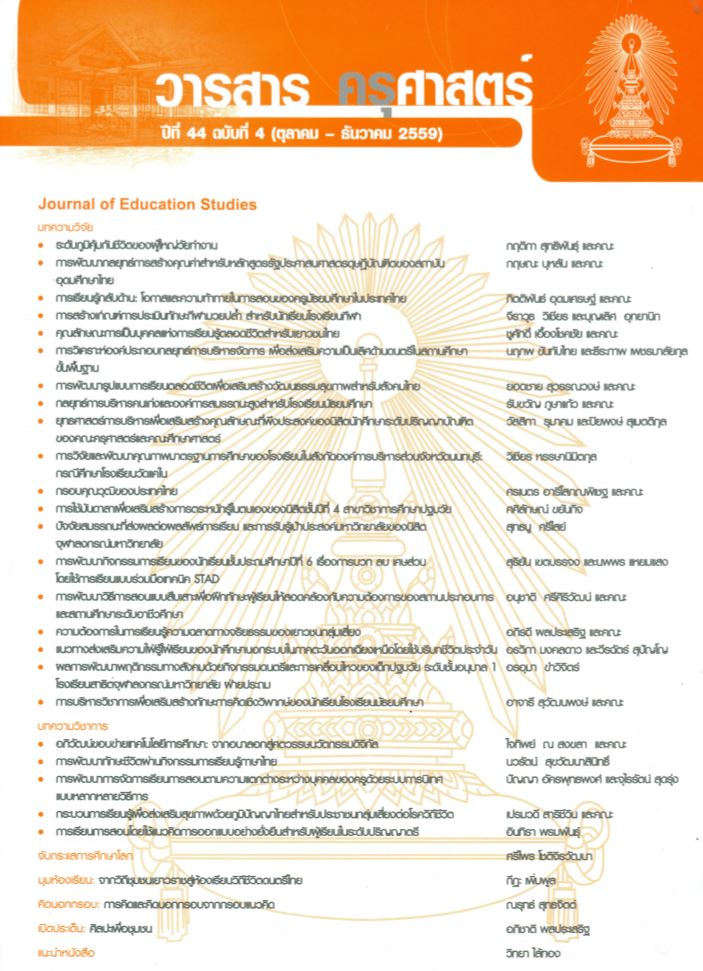อภิวัฒน์ขอบข่ายเทคโนโลยีการศึกษา: จากอนาลอกสู่ศตวรรษนวัตกรรมดิจิทัล
Keywords:
เทคโนโลยีการศึกษา, มาตรฐาน และตัวชี้วัดงานเทคโนยีการศึกษา, Educational Communication Technology, Standards and Indicators of Educational TechnologistAbstract
ระยะเวลากว่าครึ่งศตวรรษของการก่อตั้งศาสตร์ทางด้านเทคโนโลยีการศึกษาหรือที่รู้จักกันในชื่อเดิมว่า “โสตทัศนศึกษา” ขึ้นในฐานะศาสตร์ว่าด้วยการการประยุกต์ เทคนิควิธีการ แนวความคิด อุปกรณ์และเครื่องมือเพื่อช่วยในการสนับสนุนคุณภาพของการจัดการเรียนการสอน (ชัยยงค์ พรหมวงศ์, 2521) ซึ่งในปัจจุบันเทคโนโลยีการศึกษาได้มีการพัฒนาเปลี่ยนแปลงไปอย่างต่อเนื่องและรวดเร็วจากการประยุกต์อุปกรณ์ช่วยสอน สื่อ วีดิทัศน์ และบทเรียนมัลติมีเดียด้วยตนเอง ไปสู่การใช้เทคโนโลยีดิจิทัลเพื่อการเรียนรู้ที่เกิดขึ้นได้ทุกที่ทุกเวลา ผู้เรียนมีอิสระในการเข้าถึงสื่อและบทเรียนต่างๆ ได้ง่ายดายและสะดวกขึ้น โดยกิจกรรมการเรียนการสอนมีทั้งที่อยู่ในรูปแบบการเรียนรู้แบบรายบุคคลและแบบกลุ่มซึ่งผู้เรียนสามารถที่จะบริหารจัดการการเรียนของตนเองได้ นอกจากนี้ผู้เรียนยังสามารถพูดคุย ติดต่อและการสื่อสารแลกเปลี่ยนเรียนรู้กับผู้เรียนคนอื่น ๆ ได้พร้อม ๆ กันผ่านเครือข่ายสังคม โดยการเผยแพร่ส่งต่อสารในลักษณะนี้จะเรียกว่าไวรัล (Viral) ซึ่งไวรัลจะส่งผลต่อความคิด ความรู้ใหม่ ๆ อยู่เสมอ บทความนี้มีวัตถุประสงค์ที่จะเสนอนิยามของเทคโนโลยีและสื่อสารการศึกษาจากการทบทวนโดย สมาคมเทคโนโลยีและสื่อสารการศึกษา (Association for Educational Communications and Technology (AECT)) ซึ่งเป็นผู้ก่อตั้งศาสตร์ทางด้านเทคโนโลยีการศึกษาขึ้นมาครั้งแรก ในปี ค.ศ. 1923 (พ.ศ. 2466) หรือราวเกือบร้อยปีมาแล้ว การเรียนรู้ที่มุ่งเข้าสู่ศูนย์กลางที่ผู้เรียนรายบุคคลสามารถเลือกรับความรู้ คัดสรรเองตามวัตถุประสงค์เรียนรู้ที่เชื่อมโยงและต่อยอดโครงข่ายตามความคิดของตนเอง (Semantic network) สร้างสรรค์นวัตกรรมที่ต่อยอดอย่างไม่หยุดนิ่ง ซึ่งถือเป็นการอภิวัฒน์สมรรถนะและบทบาทของทั้งผู้เรียนและนักเทคโนโลยีการศึกษาในโลกดิจิทัลไปจากเดิมโดยสิ้นเชิง
For more than half a century of an establishment of educational technology field, known as, "Audio Visual Education", as science of application, echniques, concepts and tools in supporting a teaching and learning quality. A continuous development of the field mainly from instructional aids to media, video, and self-paced learning multimedia, a movement to digital technology for learning that can occur at any time in any places through a connection of computer network. Beyond an individual and group learning, communication and knowledge sharing are happening simultaneously on a social network. A wide spread and speedy of messages though a material via a social media so-called Viral affects ideas and always new and fresh knowledge. The article proposes a definition of Educational and Communication Technology and its contemporary standards, reviewed by Educational Communications and Technology Association (AECT), the founder of the Educational Technology since or the 1923 (B.E. 2466). When learning turns to center around an individual learner who inquire and acquire knowledge based on his/her desire to learn, and elaborate the network of his learning (semantic network) that elicits an endless knowledge thread. The revision of Standards and Key Performance Indicators are presented for a new role of Educational Technologist in the digital era.




